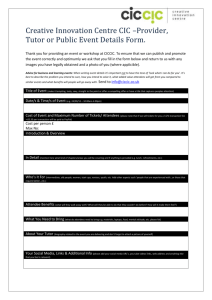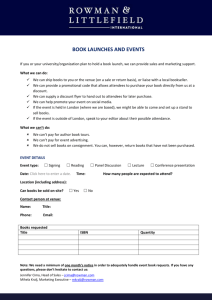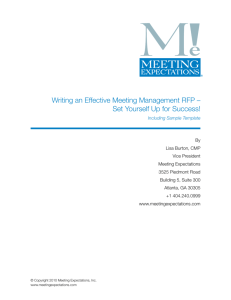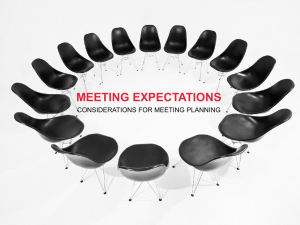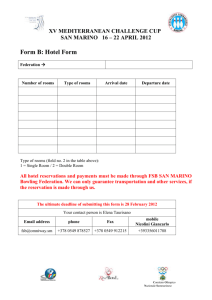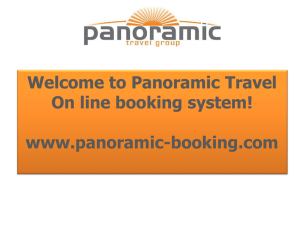Meeting Planning Reference & Checklist
advertisement
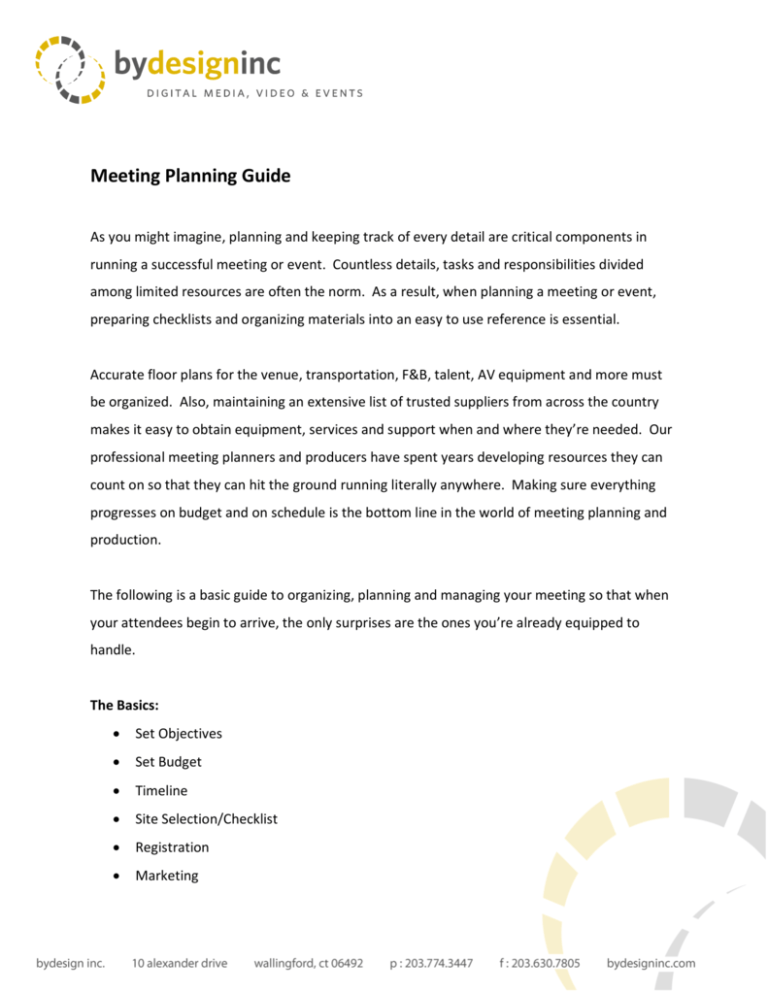
Meeting Planning Guide As you might imagine, planning and keeping track of every detail are critical components in running a successful meeting or event. Countless details, tasks and responsibilities divided among limited resources are often the norm. As a result, when planning a meeting or event, preparing checklists and organizing materials into an easy to use reference is essential. Accurate floor plans for the venue, transportation, F&B, talent, AV equipment and more must be organized. Also, maintaining an extensive list of trusted suppliers from across the country makes it easy to obtain equipment, services and support when and where they’re needed. Our professional meeting planners and producers have spent years developing resources they can count on so that they can hit the ground running literally anywhere. Making sure everything progresses on budget and on schedule is the bottom line in the world of meeting planning and production. The following is a basic guide to organizing, planning and managing your meeting so that when your attendees begin to arrive, the only surprises are the ones you’re already equipped to handle. The Basics: • Set Objectives • Set Budget • Timeline • Site Selection/Checklist • Registration • Marketing • Contracts Setting objectives Before selecting a site or beginning to negotiate with hotels, it’s helpful to establish the purpose of the event and articulate what it needs to accomplish so that the entire team clearly understands the mission at hand. There are ten main things to consider when setting meeting objectives: 1. What is the purpose of the meeting? Can a clear written statement of why this event is being conducted be created? Does it agree with the top priorities of your organization? 2. Can quantifiable goals be established with clear measurement of achievement for the event by which success can be determined? In other words, try to make the meeting objectives specific, measurable, attainable and realistic. 3. Who will be attending? Identify all stakeholders in the meeting (attendees, organization leaders, facilities professionals, etc.), and set priorities. Which group's needs come first? 4. What should attendees remember most about the event? Summarize the experiences attendees should have? 5. What does prior history teach about this meeting? Is there information that would be useful to the team in determining the potential for success - or failure - of this meeting? 6. Who else has conducted the meeting or the same type of meeting, and what can be learned from their experiences? Talking with these meeting planners can be a big help in avoiding pitfalls and setting effective and realistic goals. 7. Do we have the resources necessary to achieve our objectives? Can we successfully conduct the event with the staff we have, or do we need to consider outsourcing part or all of it? 8. Have you sought input from the planning team? Have you asked previous attendees for their comments and suggestions? 9. How will we reach our intended audience? What type of marketing and promotion will be needed to spread the word about the event? 10. How will we monitor and determine the success of the effort? Develop measurement tools that address the pre-meeting process, all on-site meeting elements, and the various post-meeting outcomes. A comparison of previous attendance and revenue with your event is basic. Surveys of attendees both onsite during the event and postevent surveys of stakeholder groups once they have returned home will be very useful in gauging the success of the event. Having these planning elements in place before you begin preparing for your event will get your team launched in the right direction. Meeting Timeline/Checklist Producing a successful meeting or event involves a myriad of tasks and milestones throughout the planning process. A solid production schedule is essential to ensure no detail drops through the cracks. Every event can have unique elements requiring attention, but by and large, the following provides a reasonable long-range planning guide for larger meetings and events. Although not all of the tasks may apply to your particular event, it will serve to layout the order and general timing of major tasks and should assist with the creation of a specific production schedule. 17 – 18 Months Out • Set objectives, meeting/exhibit dates, locale, theme, and format. • Conduct site visit. • Set preliminary budget. • Select freight company. • Negotiate hotel rates and blocks, sign hotel contracts. • Negotiate fares with official airline. • Select ground operator. • Select official car-rental agency. • Assemble exhibitor lists. • Set registration fees and policy. • Define promotional strategy. • Prepare first calendar notices and press releases for exhibit. 16 Months Out • Arrange insurance coverage. • Develop logo/graphics theme. • Select exhibit service contractor. • Establish exhibit space rates. • Produce exhibit floor plan. 14-15 Months Out • Invite and confirm key speakers. • Determine preliminary F&B requirements. • Negotiate menus and prices. • Adjust exhibit floor plan (continuous). • Prepare and mail first meeting announcements and promotional materials to prospective attendees. 13 Months Out • Get speakers' AV needs. 6-7 Months Out • Produce and mail second promotion to prospective attendees. • Begin processing registration forms. 4-5 Months Out • Prepare and mail third promotion to prospective attendees. • Adjust budget. • Confirm AV requirements. • Assign speaker locations/times. 2-3 Months Out • Adjust budget. • Open host-city bank account. • Finalize session schedule and room assignments. • Select and contract with AV supplier. • Produce and mail exhibitor services kits; include AV order form. • Finalize F&B schedule. • Determine on-site staff needs. • Determine security needs. • Order office and communications equipment needed on-site. • Order signage. • Compile exhibitor directory. • Finalize on-site computer requirements for registration. • Review processing and billing activity with hotels. 1 Month to 6 Weeks Out • Print conference guide. • Print workbooks. • Submit daily schedule to hotels. • Produce badge and ticket stocks. 3 Weeks Out Through Day of Meeting • Set up on-site office. • Pack and inventory materials. • Assemble registration packets. • Finalize F&B guarantees. • Make pre-event preparations on-site. • Supervise meeting on-site. Post-Meeting • Pack and inventory materials. • Reconcile finances. • Do a post-budget review. Site Inspection Checklist The goals and objectives of the meeting will dictate site selection. If the goal is excitement and entertainment, you might need a special venue like a theater. If the goal is recreation, you might require athletic fields. If the goal is education and reflection, you would require a property with few distractions. If the goal is networking, you need big spaces to meet and mingle. If the goal is a multi-format event, you might need large meeting rooms, small breakout rooms, an exhibit hall etc. This is where you’ll need to put yourself in the position of the production people, registration people, presenters, and of course the attendees. Often, assumptions made without experience prove very wrong. From the size of the room, height of the ceiling, crowd flow, dinner facilities to area attractions, weather, security – the list goes on and on. In the end, that list will largely determine the degree of success your event can achieve. The following basic considerations and suggestions provide a starting point for the selection of your location and venue: • Location. Where is your membership based? If you're east of the Mississippi and your members are on a tight budget, stay in the East. • Review the records from previous events. Well-kept records will provide a wealth of information to help select the next location and venue. • Demographics. Your membership is always changing in some way. Capture and analyze your group demographics. This will enable you to make adjustments to the way you are doing things. • Finances. Develop a budget and figure out what factors have contributed to financially successful meetings in the past. • Do a SWOT (Strengths, Weaknesses, Opportunities, and Threats) analysis. Is the location easy to get to? Is it an expensive area? Will the location draw people to it? Are there other meetings or events in the area that could drive up costs and monopolize available labor? Consider any aspect of the city, the location and the property that could affect the success of your event. o Getting there. What are the costs and the ease of getting to the location? How does it relate to member needs? You might be able to get great rates in a northern city in the winter, but can your members get there and back on time? o Seasonal economics. You do a lot better on rates in Miami in August than in February or March, for example. o Geographic flow: Do you have to move your meeting around in order to satisfy everybody, or can you keep your meeting in the same location? o Cultural perception: How will your attendees view a city or a property? Many of us read about beautiful new facilities. We like to bring our people to new places. On a site visit, the facility is gorgeous and operating well. But many times new facilities are built in unsafe areas because the land is less expensive. It might be best to wait a few years before taking a meeting to a new hotel or convention center. New development will happen around the facility, and it will be a much more inviting location. o Local resources: resources are people such as the convention bureau, the chamber of commerce, the mayor's office, and the police and fire departments. How willing are they to work with you? o Friends and allies. You have them in every city. For example, an ally might be someone who just had a meeting in the same facility. Planners always are happy to share their knowledge with others in the same situation. Take advantage of their experience. o Costs. What are the costs of labor, and what are the taxes? o Competition. What groups are going to be in town at the same time? o Overflow. Is there overflow space, in case you attract great attendance? Look at the properties around yours and the value they provide. o Rates. This means more than the hotel rates. It's food and beverage, sleeping rooms, meeting rooms, parking, flowers, photographers. There are probably 35 or 40 rates to consider. o Dates. If your meeting is June 15-17, protect rooms for June 13 and 14, because that's when you, your staff, and your organization's leadership likely will arrive. If your attendees like to stay over for other activities, look at availability for the dates after your meeting. o Space. People need and want a break from being inside. Is there space for activities outside the hotel? o Available sleeping and meeting rooms. A 500-room hotel might have only 380 rooms available because of agreements with airlines or other customers. o Meeting-room charges. Don't assume that meeting rooms in a hotel are going to be free. Conference rooms might be, but ballrooms might not. o Attrition clauses. Negotiate these with great care. o Other groups in the house. Ask about this early. o Exclusive contracts with service companies. It's very possible that the hotel has an exclusive contract with a florist or business center, for example. But you might be able to negotiate rates. o Complimentary-room policies. One complimentary room for 50 paid is typical, but the ratio can slide, depending on how badly the hotel wants your meeting. o Drayage and storage policies. What does it cost to move materials within the facility? How long will the property store materials that are sent for the meeting? o Remodeling. Ask what's being planned at the property and in the area. Will a wrecking ball be crashing into the building next door during your event? o Security. Will you need it at the exhibit hall, the front door, the parking lot? What will it cost? o ADA. Ask to see the facility's certificate of compliance. o Credit and payment policies. Never settle for a contract that requires you to pay on-site. You will be too distracted to go through the master account while on- site. Give yourself at least two weeks to pay so that you have the time to review the master account carefully. o Cleaning and maintenance policies. What are their schedules for the exhibit halls and the room corridors? o The back of the house. If you see swinging doors, walk through them. Go look at the loading dock and the kitchen. Its appearance could give you insight into how the facility as a whole operates. o The meeting rooms. Are there chandeliers in the ballroom that will affect projection? Or do you have the space for rear projection. Are there columns that will affect visibility? Is there a room suitable for a board meeting? o Parking. Are there enough spaces, and where is the lot? o Deal with the decision-maker. Talk with the person who signs the contract. o The process. After you've made your site visits, prioritize your favorites and begin negotiating with your top choice, keeping in mind how good or bad your second choice is in comparison. Checklist for Contracts Once you’ve decided on a location and venue, perhaps the most important place for a checklist is in your required contracts. The following can be modified to fit the needs of your meeting or event: • • Correct Meeting Dates o Verify that the meeting dates correspond with the venue’s records o Are pre- and post-event meetings/activities set? o Are there rooms for AV production people to work and for speaker rehersals? o Are set and strike dates and available time adequate? Correct Organization Name o Is the contract in your name or the name of the organization? • Complimentary Rooms o Can the earned value be deducted from the master account, or must they be assigned? o • Special Concessions o • They should be addressed in the contract, not verbally. Method of Reservations o • Are they calculated on a cumulative or daily basis? Will attendees use the hotel's reservations system or an outside service? Cutoff Date o What is the date for room-block release, and what happens to attendees who attempt to block after this date? • Hotel Management o If there is a change in the hotel brand or sale of the property, leave yourself room to cancel the contract. • Union Contracts o Should be addressed completely with contract renewal dates. o If there is a change in the union policy, did you leave yourself room to cancel or renegotiate the contract? • • • Function Space o Is enough space being held? o If unused space is to be released to the hotel, when does this happen? o Is there a charge related to function space if the room block is not filled? Payment o When are the deposits due? o Can the balance be paid in installments? o When is the final balance due? Attrition • o What percentage of the room block are you committing to sell? o How is the penalty calculated? o Is the penalty based on lost revenue or lost profit? Room Types o If the hotel's room types change significantly, leave room to renegotiate (i.e., if 75 percent of your block needs to be double/double or 30 percent smoking rooms, and the hotel renovates or changes policy, it could drastically affect the potential to sell your room block.) • Room Block o Have you blocked enough rooms? o Do you have rooms blocked on shoulder dates? o Is the room rate correct? o Have you established a formula for calculating room rate at a future date? (If you are signing a contract years in advance, this may be necessary.) • Early Departure Fees o In the event of a guest's departure prior to their check-out date, is there are fee? Who pays this fee? o • Are there exceptions for personal or professional emergencies? Additional Charges o Are additional charges (e.g. parking, luggage handling, resort fees, AV, shipping/receiving) addressed? • Miscellaneous Items Carefully review the following items. o Cancellation clause o Compliance with law clause o Changes, additions, stipulations or deletions clause o Litigation clause o American With Disabilities Act Compliance (ADA) clause o Indemnification clause Consider Online Registration Online registration makes it easy for your meeting attendees to register for the event and easy for you to administer the process, but your approach to announcing and promoting your event can have an impact on the success of your online registration system. • Know your demographics. To some degree, younger people will tend to register online without a problem while older people will use faxes or register by phone. This is changing with so many people online but it is still a consideration. • People tend to respond in the way they’re contacted. E-marketing programs tend to yield more online registrations. On the other hand if you mail out a lot of registration forms, that’s what you’re going to get back. • Consider offering a discount to attendees who register online. • If you announce the meeting electronically and give them a quick link back, then they are going to tend to register online. Creating a Meeting Budget The key to developing an income and expense budget is to include every element that may be part of your event. It is better to maintain a complete list of budget items, even if you don't need all of them at this moment, than to overlook an item. Income Registrations: • Full-paying registrations • Partial-paying registrations • Spouses • Speakers • Guests • Organizational leaders • Exhibits/displays • Exhibitor personnel • Sponsorships • Advertising • Grants/contributions Expenses • • • Food and Beverage: o Minimum guarantees o Cashiers o Gratuities/taxes o Surcharges for special events o Table centerpieces o Print materials (menu, program book, special mementos) Speakers/Presenters/Entertainers: o Fees (what do they include?) o Travel (airfare class, out-of-pocket, per diem, ground transport, hotel) o AV needs (include equipment for rehearsals, speakers' lounge) o Handouts, print materials Facilities: o Meeting/function room rental o Room sets, labor, partitions, risers o AV (in-house or independent contractor) o Signs, monitors, headers o Telephone/fax/electronic communications • • • o Printing/duplication/copy machine rental o Lighting/staging/labor (don't forget rehearsals) o Security o Cleaning o Flipcharts, easels, markerboard rentals o Electrical power, electricians o Complimentary room provisions o Staff gratuities o Special licenses, fees Audiovisual/Equipment: o Breakout and general session equipment o Rehearsals and “ready rooms” o Labor calls o Leadership meetings Registration/Information: o Badges o Program books o Registration kits o Computer equipment rental o Admission tickets o Registration personnel o Decorations (booths, headers, signage, lighting, special decorations, etc.) o Service/information desks Transportation: o Shipping, drayage o Airfare (staff, speakers, leadership) o Parking o Airport shuttles • • • o Limousines o Transportation for off-site events Printing/Postage: o Advance promotion o Registration materials o Directional/identification signs o General correspondence, special stationery o Handouts o Special notices, press releases, press kits o Confirmation correspondence with registrants o Forms and documents o Event evaluation forms o Convention and Visitors Bureau materials Staging and Decorations: o Pipe and drape for exhibits & displays o Risers, stages o Lighting and sound for general sessions & breakouts o Carpet rental for hard floor registration, exhibit areas o Podium signs o AV mixers & operators o Special electrical hookups o Pads, pencils, water stations & other meeting room supplies Fees: o Legal fees/contract reviews o Music licensing fees o Union charges o Refuse removal fees o Insurance riders for special events o Furniture and equipment rental charges o Community taxes, fees Your budget checklist will become a major part of the overall meeting or event checklist. It provides an important part of a planner “to-do” list and is an asset in making certain that all functions are being considered, strategically and financially. Marketing Your Meeting A marketing plan brings a coordinated approach to hundreds of techniques available to achieve your meeting's objective. This is where attention to a thoughtful approach saves the organization money and pays off in the long run. Keep the purpose and objective of your meeting firmly in mind. Also determine the result you expect from your marketing program? It’s not necessarily easy to achieve a large attendance goal for your event. The economy today may certainly have a negative effect. Even if there’s no charge for you meeting, travel and living expenses can be prohibitive for potential attendees. You’re also competing for the valuable time of busy professionals. So when developing a marketing plan, you want a strategy that communicates a sense urgency, importance and value to your intended audience. The following are points to keep in mind as you develop the marketing plan: o Divide your target audience into two separate groups. o Internal – employees, management/leadership and organization members Marketing to an internal customer takes more of a personal approach. A personal invitation in the mail, an newsletter announcement, e-mail invitations, or a board report with minutes announcing the upcoming meeting have become quite standard. Marketing to an internal attendee does not require as much marketing, especially to those for which the meeting is mandatory. o External – but allied individuals and groups When marketing to an external attendee, you have to provide very specific information upfront. Clearly state the benefits of attending and the pricing. You have to put yourself in the attendee's shoes and ask the question “What will this meeting do for me?” Today, technology offers a new range of cost-effective techniques. Most successful events are marketed using an integrated approach where each of several techniques builds upon the others. An example of a combination of marketing pieces might begin with a postcard inviting potential attendees to the meeting's Web site for more information or simply to register online. Follow up the above approach with an e-mail blast outlining an incentive for registering early. The message must have the organizations name and meeting name clearly stated in the subject line to avoid being deleted. If you have an organization e-newsletter, place the link to the page where the meeting information is listed in the very first paragraph. Add a testimonial from a respected past attendee. Follow the e-newsletter with a mailing of a four-color printed brochure highlighting important sessions, speakers, or social activities. Use public relations. News releases, media relations and news coverage will allow you to reach large numbers of potential attendees for a relatively small investment. Combining marketing techniques continuously reminds the target audience about your event. By using creativity and technology, you can pique the curiosity of potential attendees.

